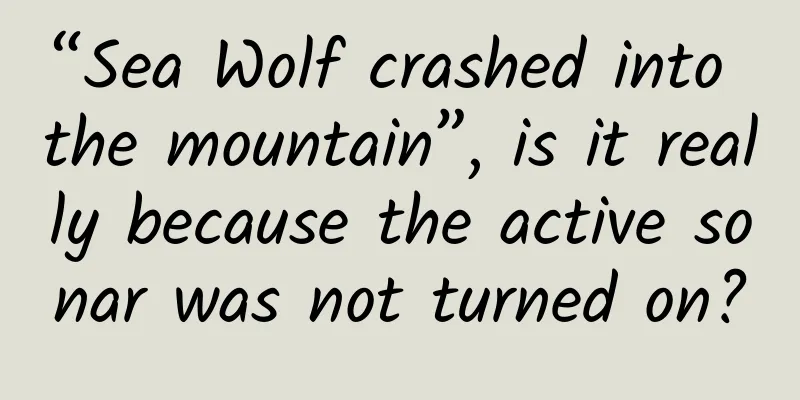“Sea Wolf crashed into the mountain”, is it really because the active sonar was not turned on?

|
Produced by: Science Popularization China Produced by: Dahui Producer: Computer Network Information Center, Chinese Academy of Sciences On October 2, 2021, the U.S. Seawolf-class attack nuclear submarine USS Connecticut had an underwater collision accident. The U.S. military has been covering up the cause of the accident. It was not until November 1 that the U.S. 7th Fleet issued an accident investigation statement saying that the object the submarine collided with in the South China Sea was an "unknown submarine mountain." Satellite photo of the USS Connecticut nuclear submarine taken on October 20 (Photo source: The Drive website "War Zone" column) Why did the most advanced "Sea Wolf" class nuclear attack submarine collide with a "sea mountain"? Can similar "Sea Wolf collision with a sea mountain" accidents be avoided? How can submarines avoid collisions and other navigation accidents when sailing underwater? Today, we will take the "Sea Wolf crashing into the mountain" incident as an opportunity to talk about submarine underwater navigation, positioning and collision avoidance methods based on public information. Was the failure to turn on active sonar the reason for the crash into the mountain? After the collision, many analysts believed that the main reason for the collision was that the nuclear submarine was operating in secret and the active sonar was not turned on. However, should active sonar really be blamed for the “Sea Wolf crashing into a seamount”? As we all know, sound waves are currently the only carrier that can effectively transmit information over long distances in seawater. Sonar, the main equipment for submarine navigation and positioning, uses sound to achieve underwater navigation, measurement and positioning. The origin of the word “SONAR” is actually the abbreviation of “Sound Navigation And Ranging” in English. Modern advanced submarines are usually equipped with spherical sonar arrays at the bow, side array sonars at the sides, and towed linear array sonars at the stern. Nuclear-powered attack submarines in particular can be equipped with up to 15 sonars. Schematic diagram of submarine underwater navigation sonar detection (Photo source: Phoenix.com) These sonars can be divided into warning sonar, attack sonar, mine detection sonar, communication sonar, identification sonar, passive ranging sonar, and environmental noise recording and analysis, sound speed measurement, and sound trajectory calculation sonar according to their functions. They are integrated into the submarine in the form of a base station system and are used for search, identification, tracking, warning, detection, positioning and underwater acoustic communication of surface targets such as ships and submarines, mines, torpedoes, as well as underwater active or fixed targets such as icebergs and seabed obstacles. Schematic diagram of hydroacoustic confrontation between submarines and surface ships and aircraft (Image source: Reference 1) At the same time, the submarine sonar system can continuously monitor and analyze the sound propagation conditions in the active sea area, the submarine itself and the environmental noise, so as to select the best tactical maneuvers and sonar use methods. It should be emphasized that most of the current submarines, including nuclear-powered attack submarines, are equipped with "active sonar" at the bow, while the side arrays and stern towed array sonars are mostly "passive sonar". The so-called active sonar is the active emission of sound waves for underwater target detection and communication; Passive sonar does not emit sound waves, but passively monitors and collects target sound information for detection, orientation and tracking. In order to maintain stealth, submarine sonar systems mainly work in passive mode. The active working mode is only used to locate the target before the torpedo is fired, and to provide the torpedo weapon firing command system with precise target coordinate data. It can be said that active sonar is not mainly used to ensure the navigation of submarines, but to carry out torpedo attacks. According to publicly available information, the Seawolf class nuclear submarine is equipped with the AN/BQQ-10 ARCI V5 sonar system. Among them, the bow is equipped with a BQS-13DNA active/passive sonar, the side is equipped with six (three on each side) BQG-5 wide aperture array sonars, and the stern is equipped with two towed sonar arrays (TB-16D thick array and TB-29A thin array). In addition, it is also equipped with BQR-20 noise direction-finding sonar, BQS-24 mine detection and collision avoidance sonar, WLR-9A reconnaissance sonar and WQC-2 communication sonar. It is particularly important to point out that the Seawolf-class sonar system is extremely advanced, reaching the highest level of attack nuclear submarines. It can use passive sonar to accurately measure the target's side angle during the boat's maneuvers, accurately calculate the motion elements of distant targets, and automatically generate fire control parameters. So, stop saying that the Sea Wolf crashed into the mountain because the active sonar was not turned on! So, besides sonar, what other means are there for submarines to navigate and locate underwater? How do submarines navigate and position themselves when sailing underwater? You may be familiar with the navigation and positioning of surface ships, cars, etc. As long as you have detailed nautical charts or maps, as well as maritime navigation marks or road signs, you can get on the road safely and conveniently and reach your destination accurately. However, when a submarine is sailing underwater, it cannot see navigation marks, receive GPS signals, or effectively receive radio signals. Even receiving command information must be completed within a specified time limit. Especially when a nuclear submarine is performing a stealthy underwater navigation mission, even loud noises are not allowed to be made on the submarine. In this case, how do submarines navigate, locate, and avoid collisions? Is sonar the only means? In fact, modern submarines are also generally equipped with advanced electronic chart systems, inertial navigation systems, geomagnetic field positioning systems, gravity field positioning systems and seabed terrain/image matching systems. Among them, the inertial navigation system is an advanced navigation device that ensures that underwater submarines determine and maintain their course. The main components of this system are gyroscopes and accelerometers. It establishes a navigation coordinate system based on the output of the gyroscope and calculates the speed and position of the vehicle in the navigation coordinate system based on the output of the accelerometer. Moreover, the inertial navigation system is an autonomous navigation system with strong anti-interference performance. It neither relies on external information nor radiates energy to the outside. It is very suitable for submarines that need to sail stealthily underwater for a long time. The system is installed on a submarine. By measuring the acceleration of the submarine and automatically performing integration operations, it obtains the submarine's instantaneous speed and position data, and displays them in the navigation coordinate system, thereby obtaining information such as the submarine's heading, speed, yaw angle and position. After the inertial navigation system solves the submarine's heading and speed perception problems, it is also necessary to solve the submarine's own position, the relative position of the submarine and various underwater navigation obstacles (obstructions), and the position perception relationship between the submarine and other underwater moving targets, and establish a full range of relative motion postures, in order to effectively avoid collisions and ensure safe navigation. At this time, it is necessary to use the geomagnetic field, gravity field positioning system and seabed terrain/image matching system together with the sonar system to present the submarine's own position, course, speed and other information, the marine environment information around the submarine, unidentified submarines, mines, icebergs and seabed obstacles, etc. in the form of a comprehensive situation map through the electronic chart system. The submarine commander can use this to control the submarine to avoid danger and attack the enemy. It can be said that modern submarines, in addition to sonar systems, also rely on a variety of systems to complement and verify each other, and through intelligent display technology, they can promptly detect obstacles, accurately avoid various navigation hazards, and ensure that submarines sailing underwater safely in the established course and depth. The issue of submarine navigation safety has always been of concern to people, and the "Sea Wolf crash" incident has once again aroused the attention of all parties to submarine navigation safety. Therefore, as my country's Foreign Ministry spokesman Wang Wenbin said, only by explaining the relevant circumstances of the accident in detail can we fully respond to the concerns and doubts of all sectors. References: Du Zhaoping et al., "A Review of the Development of Foreign Sonar Technology", Ship Science and Technology, 2019.41-1. |
<<: Popular Science | How come there are different colored corn kernels on the cob?
Recommend
The most powerful growth method for user retention
What is a behavioral model? In fact, it is a habi...
Apple is said to have launched generative AI features in iOS 18, including cloud and device
Haitong International Securities analyst Jeff Pu ...
How much does it cost to customize Dehong furniture through the mini program? What is the price quote for Dehong Furniture Mini Program customization?
There are two types of customization of Dehong Fu...
Minimum server rental fee
What is the lowest cost for renting a server? The...
Hot topics: Monthly salary of 30,000+ essential skills for new media operations!
Hot spots are like a stimulant that is worth a lo...
What will happen to your body if you eat one sausage a day? Is it okay to eat a sausage that costs 2 yuan?
"Give me a sausage, thank you!" Image s...
How to solve the high user churn rate? Here are 10 strategies
Many companies have not developed specific plans ...
Raising 500,000 babies for others and then having to return them, what is this doing?
Biologist Celia Leto dives to the bottom of the o...
"Nine satellites in five days, three rockets", what does China's recent consecutive successful launches mean?
At 6:53 on August 9, my country successfully laun...
Commercialization strategy of e-commerce search traffic distribution
In this chapter, we explain the commercial distri...
The Secret of APP Mother and Baby Products Community Operation
The development of online communities has gone th...
An information flow optimizer who consumes more than 2 million per month will teach you how to do advertising scientifically!
With the vigorous development of mobile communica...
If you drink antifreeze by mistake, can liquor become a "life-saving medicine"?
Review expert: Peng Guoqiu, deputy chief physicia...
The real car of Zhinuo 60H with plug-in hybrid system is exposed
Recently, we took the first photos of the new ZIN...
Douyin short video "Film and Television Editing and Sales All-round Class" from entry to mastery, play and make money in short video operation
Training course video lecture content introductio...









